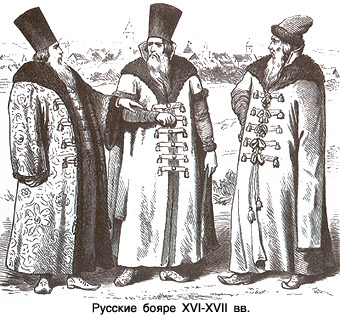Boyar hat on:
[Wikipedia]
[Google]
[Amazon]

 The boyar hat (russian: боярская шапка, more correct Russian name is горлатная шапка, gorlatnaya hat) was a
The boyar hat (russian: боярская шапка, more correct Russian name is горлатная шапка, gorlatnaya hat) was a  In average, it was one
In average, it was one

fur
Fur is a thick growth of hair that covers the skin of mammals. It consists of a combination of oily guard hair on top and thick underfur beneath. The guard hair keeps moisture from reaching the skin; the underfur acts as an insulating blanket t ...
hat worn by Russian nobility between the 15th and 17th centuries, most notably by boyar
A boyar or bolyar was a member of the highest rank of the Feudalism, feudal nobility in many Eastern European states, including Kievan Rus', Bulgarian Empire, Bulgaria, Russian nobility, Russia, Boyars of Moldavia and Wallachia, Wallachia and ...
s, for whom it was a sign of their social status. The higher hat indicated the higher status.
 In average, it was one
In average, it was one ell
An ell (from Proto-Germanic *''alinō'', cognate with Latin ''ulna'') is a northwestern European unit of measurement, originally understood as a cubit (the combined length of the forearm and extended hand). The word literally means "arm", and ...
in height, having the form of a cylinder
A cylinder (from ) has traditionally been a three-dimensional solid, one of the most basic of curvilinear geometric shapes. In elementary geometry, it is considered a prism with a circle as its base.
A cylinder may also be defined as an infin ...
with more broad upper part, velvet
Weave details visible on a purple-colored velvet fabric
Velvet is a type of woven tufted fabric in which the cut threads are evenly distributed, with a short pile, giving it a distinctive soft feel. By extension, the word ''velvety'' means ...
or brocade
Brocade is a class of richly decorative shuttle-woven fabrics, often made in colored silks and sometimes with gold and silver threads. The name, related to the same root as the word "broccoli", comes from Italian ''broccato'' meaning "embos ...
top and the main body made of fox
Foxes are small to medium-sized, omnivorous mammals belonging to several genera of the family Canidae. They have a flattened skull, upright, triangular ears, a pointed, slightly upturned snout, and a long bushy tail (or ''brush'').
Twelve sp ...
, marten
A marten is a weasel-like mammal in the genus ''Martes'' within the subfamily Guloninae, in the family Mustelidae. They have bushy tails and large paws with partially retractile claws. The fur varies from yellowish to dark brown, depending on t ...
or sable
The sable (''Martes zibellina'') is a species of marten, a small omnivorous mammal primarily inhabiting the forest environments of Russia, from the Ural Mountains throughout Siberia, and northern Mongolia. Its habitat also borders eastern Kaza ...
fur.
When taken off, the hat was often held above the forearm, between hand and elbow
The elbow is the region between the arm and the forearm that surrounds the elbow joint. The elbow includes prominent landmarks such as the olecranon, the cubital fossa (also called the chelidon, or the elbow pit), and the lateral and the media ...
, or worn as a muff. When at home, the hats were preserved on wooden stands that were adorned with painted designs.
Today the hats of this type are sometimes used in the Russian fashion
Fashion is a form of self-expression and autonomy at a particular period and place and in a specific context, of clothing, footwear, lifestyle, accessories, makeup, hairstyle, and body posture. The term implies a look defined by the fashion in ...
.
References
{{Reflist *Киреева Е. В. «История костюма. Европейский костюм от античности до XX века.» Москва. Просвещение. 1976 / Kireeva E. V. ''The history of costume. European costume from Antiquity into the 20th century.'' Moscow, Prosvescheniye, 1976. 15th-century fashion 16th-century fashion 17th-century fashion 18th-century fashion 19th-century fashion 20th-century fashion Hats Russian clothing Russian inventions Fur